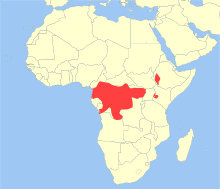De Brazza's monkey

De Brazza's monkey

| De Brazza's monkey[1] | |
|---|---|
Conservation status | |
| Scientific classification | |
| Kingdom: | Animalia |
| Phylum: | Chordata |
| Class: | Mammalia |
| Order: | Primates |
| Suborder: | Haplorhini |
| Infraorder: | Simiiformes |
| Family: | Cercopithecidae |
| Genus: | Cercopithecus |
| Species: | C. neglectus |
| Binomial name | |
| Cercopithecus neglectus Schlegel, 1876 | |
 | |
| Geographic range | |
The De Brazza's monkey (Cercopithecus neglectus) is an Old World monkey endemic to the wetlands of central Africa. It is one of the most widespread African primates that live in forests.[2]
| De Brazza's monkey[1] | |
|---|---|
Conservation status | |
| Scientific classification | |
| Kingdom: | Animalia |
| Phylum: | Chordata |
| Class: | Mammalia |
| Order: | Primates |
| Suborder: | Haplorhini |
| Infraorder: | Simiiformes |
| Family: | Cercopithecidae |
| Genus: | Cercopithecus |
| Species: | C. neglectus |
| Binomial name | |
| Cercopithecus neglectus Schlegel, 1876 | |
 | |
| Geographic range | |
Etymology
Locally known as swamp monkeys,[3] these primates are named after the Italian-French explorer Pierre Savorgnan de Brazza.
Description
This guenon has grey agouti fur with a reddish-brown back, black limbs and tail and a white rump. A white stripe runs down its thigh, and an orange crescent-shaped marking appears on its forehead. Its white eyelids match its muzzle and beard. Due to this distinctive appearance, the monkey is sometimes referred to as the "Ayatollah Monkey" after the similarly-bearded Grand Ayatollah Ruhollah Khomeini. Both sexes have cheek pouches in which to carry food while they forage, and males have a blue scrotum.
Distribution and habitat
De Brazza's monkey ranges across the swamps, bamboo and dry mountain forests of Angola, Cameroon, Central African Republic, Congo, The Democratic Republic of the Congo, Equatorial Guinea, Ethiopia, Gabon, Saiwa Swamp and the Cherangani Hills in Kenya, South Sudan, Nigeria and Uganda. They are mainly arboreal.[2][5]
Behavior

Mother with young
The lifespan of the De Brazza's monkey in the wild is about 22 years, but it is thought to correspond similarly to other members of Cercopithecus which live up to 30 years in captivity. It is a shy, territorial monkey that lives in small social groups. De Brazza Monkeys live in groups varying from 5 to 30. At the head of each social group is the strongest male, whose job is to protect his fellow group members.[4]
De Brazza's monkey communicates with booming sounds, shaking tree branches, and a variety of facial expressions and movements (e.g. shaking its head when stressed out, or nodding with approval).[4]
Predators of the De Brazza's monkey include the leopard, humans, and common chimpanzees.[4]
